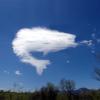I've kept a fishing journal for a long time now. My first entry was in May 1976. Wow, I guess I've broken 30 years. I wouldn't have noticed if it wasn't for the 9 volumes on the bookcase and the graying hair in my mirror. I also wouldn't remember half of what actually transpired on all those fishing days. Memory, it turns out, is really a lot of subjective mush not unlike dreams.
Here are some suggestions, through my filter:
There are lots of recipe book type logs out there that offer a list of things to fill in. I think these simply leave too much out and lack the flexibility and space for the information that really fleshes out a day on the water.
There are also on-line databases you can buy, which I think is overkill. I just never record enough actual data, and there are so many variables to be considered. Things like weather trends, fish behaviors, and presentation details are rarely cookbook enough to fit neatly into a field, either digital or on paper.
My journals have been kept in archive quality (acid free) 8½x11 artist's sketchbooks that start as just blank pages. I write sort of the way I'd tell a friend about how the day went; what worked or didn't, and what was interesting. More recently I've begun using word processing software on my computer to create entries, which helps a lot in organizing and editing. I then transfer this to my bound journals.
Not everything is in prose though. I dutifully keep some data that are important, and these lead off every entry, following the date:
Bod(ies) of Water: This is made obvious (in brackets) at the top of the entry so I can later refer back to specific waters easily.
Weather: The trend over the last few days is critical, as well as through the day as I fish.
Sky, water surface conditions, and water clarity (they are related in effect): changes through the day as I fish and how I adapted to them.
Water Temp: I always record surface temps when I arrive and when I leave, in roughly the same location usually right at shore somewhere that gets direct sun representing the upper limit of direct conduction. I try to take the temp at exactly the same depth (4) because it can be cooler at say 8 as heat does not penetrate far the depths are warmed over time by convection, and mixing. This recording is a benchmark telling me how rapidly the day is able to heat or cool the water.
I also record surface temps out over open water in several places as I fish. Then, I record temps where it might be different: windward and lee shores, sheltered coves, inlets etc. I usually record a couple profiles as well, to keep track of convection.
I've always done this for trout religiously but only relatively recently for bass. It has proved worthwhile, helping me understand and better judge how weather, temp, and fish relate. When I trout fished a lot it got so I could put my hand in and judge temp accurately sort of like Muddy can do with color . But I don't fish that much anymore.
Wind: Wind affects water temperature distribution which can affect fish distribution. Wind also affects surface and water conditions which affects fish spookiness, and their response to lure types and finishes.
Biological activity: I may describe any interesting activity: Insect emergences (Yes for bass too bc insects are preyfish food midge hatches are worth fishing!), plankton blooms, flowering times, even snakes in the road or frogs on the shore sunning. I record when various fish are spawning and where, any observed behaviors, size (for age) classes of fish seen, etc... . Doing this I've been able to discover strong hatch years of bass in my ponds and follow up down the road with satisfying results.
Presentation: I usually highlight lure configurations, and relevant tackle choices, and how and why they worked, or didn't.
Catches: Size (actual) and numbers. I try to tally every fish.
I keep a little notebook in my pocket for notes. Don't trust your memory it's very subjective, and this gets worse the more time has passed from the event -and I mean days, even hours. It seems I begin re-writing history almost immediately!
Sketches: I'll diagram (sketch) the ponds, lakes, or areas in lakes, recording locations of interest. I download aerial maps of these to get the shape and locations right. I sketch in bottom contours and cover, my positioning, and use symbols for wind direction and fish locations and catches. I may also sketch insects, fish, fish colorations or markings, or lure configurations anything of particular interest.
I try to journal that night when I return home. If I don't a lot of the day is lost, and I end up with mostly some hollow data. It's the thoughts, impressions, and ideas that flesh out the day. The data is important, and is the bare minimum. A really good journal entry though reads like a good fishing article, and focused on your very own piece of water.
Sounds like a lot, and can be. But it gets easier when you are in the habit. It also helps if you are fascinated by now nature works and love to write too wish I had more time for both.
Some example pages:














